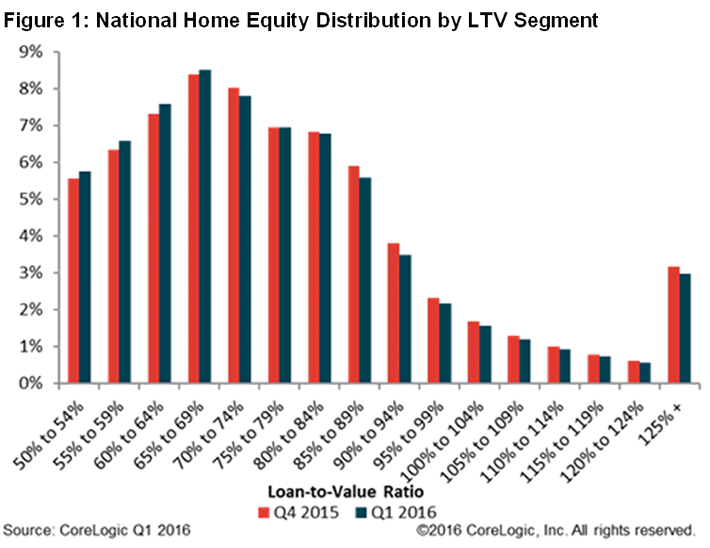Negative equity continued to decline in the first quarter of 2016. CoreLogic said today that 268,000 homeowners regained an equity position in their homes, bringing the number of homes that are still underwater down to about 4 million, 8 percent of homes with a mortgage. This is a decrease of 6.2 percent from the 4.3 million homes or 8.5 percent of the total, which were underwater in the fourth quarter of 2015.
Those homes that remain underwater, that is with mortgage balances that exceed the home's value, had an aggregate negative value of $299.5 billion at the end of the first quarter, an improvement of $11.8 billion or 3.8 percent compared to the fourth quarter of 2015. On a year-over-year basis, the value of negative equity declined overall from $340 billion in Q1 2015, representing a decrease of 11.8 percent in 12 months, as the total number of homes in a negative position fell from 5.1 million homes, a 21.5 percent improvement.
Approximately 46.7 million properties, 92 percent of mortgaged homes, are now in positive territory. Year-over-year equity nationwide increased by $762 billion
Of the more than 50 million homes with a mortgage, approximately 9.1 million, or 18 percent, have less than 20 percent equity (referred to as "under-equitied") and 1.1 million, or 2.2 percent, have less than 5 percent equity (referred to as near-negative equity). Borrowers who are under-equitied may have a difficult time refinancing their existing homes or obtaining new financing to sell and buy another home due to underwriting constraints. Borrowers with near-negative equity are considered at risk of moving into negative equity if home prices fall.
CoreLogic again pointed out equity is disproportionate across price tiers. The bulk of positive equity for mortgaged residential properties is concentrated at the high end of the housing market. For example, 95 percent of homes valued at $200,000 or more have equity compared with 87 percent of homes valued at less than $200,000.

"In just the last four years, equity for homeowners with a mortgage has nearly doubled to $6.9 trillion," said Frank Nothaft, chief economist for CoreLogic. "The rapid increase in home equity reflects the improvement in home prices, dwindling distressed borrowers and increased principal repayment. These are all positive factors that will provide support to both household balance sheets and the overall economy."
"More than 1 million homeowners have escaped the negative equity trap over the past year. We expect this positive trend to continue over the balance of 2016 and into next year as home prices continue to rise," said Anand Nallathambi, president and CEO of CoreLogic. "Nationally, the CoreLogic Home Price Index was up 5.5 percent year over year through the first quarter. If home values rise another 5 percent uniformly across the U.S., the number of underwater borrowers will fall by another one million during the next year."
The highest percentage of homes with negative equity, 17.5 percent, are in Nevada. Florida follows at 15 percent. Along with Illinois (14.4 percent), Rhode Island (13.3 percent) and Maryland (12.9 percent), these five states account for 30.2 percent of negative equity in the U.S., but only 16.5 percent of outstanding mortgages.
Texas, Alaska, Hawaii, Colorado, and Washington all had the highest percentage of homes with positive equity, all exceeding 97 percent. In the latter two states homes prices have been appreciating over most of the last year by double digits.

Of the total $299.5 billion in negative equity nationally, first liens without home equity loans accounted for $166 billion, or 55 percent, in aggregate negative equity, while first liens with home equity loans accounted for $134 billion, or 54 percent.
The 2.4 million underwater borrowers with only a first mortgage are underwater by an average of $68,000 while the 1.6 million who have both first and second mortgages have average negative equity of $84,000.







